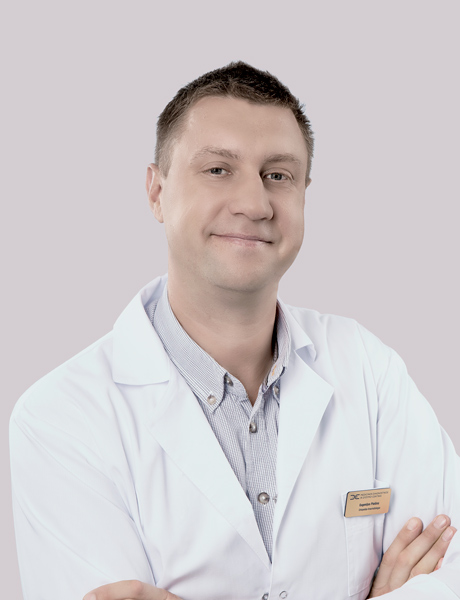2016 08 18
What dangers does a snapping shoulder blade warn of?
Injuries, Joint Disorders
4 min. skaitymo

One or two snapping sounds from the shoulder blade rarely make us worry. But it’s quite another matter when we feel pain – then, snapping shoulder blade (scapula) syndrome requires treatment. Wearisome pain and constant discomfort can stop us from exercising or engaging in physical labor. Sometimes, the pain doesn’t disappear even when we’re resting or sleeping.
“Scapula crepitation (clicking) can be felt by palpation in about 30% of people who have no complaints. When there is no pain, the condition can be considered normal. But painful, audible, felt, or palpated snapping in the scapula and the thorax junction is a clinical diagnosis,” says orthopaedist and traumatologist Eugenijus Piešina at the Medical Diagnostic and Treatment Centre on Grybo Street, Vilnius.
– What does this unpleasant sound sometimes emitted by shoulder blades mean? What are its causes?

– When the movement mechanism in the scapula and thorax junction is disturbed, this is called snapping scapula syndrome. Such a disorder can be caused by prolonged movements of the arms above shoulder level. The syndrome is caused by different factors: bursitis, muscle tone disorders, bone or soft tissue pathology, a bent upper-medial corner of the scapula, the Luschka joints, or tumors.
Scapula pains are experienced more often if the scapula or thorax is shaped incorrectly if the patient suffers from bone outgrowths or an imbalance of the shoulder line muscles, or abnormal spine curvature, for example, kyphosis in the thoracic region.
– Is it true that this disorder is characteristic among young men and middle-aged women? Why are these age groups distinguished in particular?
– More or less pronounced snapping of the shoulder blade is characteristic to approximately one-third of the population; however, painful snapping particularly occurs in young active individuals who work or exercise with their arms lifted up or who constantly perform the motion of throwing. Separate professions can be identified – snapping scapula syndrome is generally experienced by athletes, construction workers, painters, and hairdressers.
Different situations occur. Once a patient came for a check-up after a successful operation and asked me if he could bring a brother who also had a painful and snapping shoulder blade. We operated on the brother, who then brought a third brother – the last one needed as many as three operations, seeing that there were bony outgrowths in both scapulae and a rib. Once all three of them were healthy and happy, I asked if there were possibly more relatives in the family suffering from the pain of a similar nature. The brothers replied that they had a sister but that she was fine.
– Are shoulder blade pains the result of a seated position in a job or working with a computer?
– A seated position does not have a direct influence; however, an excessively low tone of muscles that move the spine and the shoulder blades indeed provokes this syndrome. Exercising is the best means of prevention and even one of the treatment stages in the event of falling ill.
– When should we start worrying? When is the time to see a doctor?
– A snapping scapula is a problem that does not receive much attention. Quite often, the syndrome is simply not diagnosed due to a lack of knowledge. General practitioners and even some specialists are not able to recognize this syndrome. If the pain is not intense, the patients simply get tired of trips to the clinic. Without an answer to what is wrong with them and why the pain doesn’t go away, they quite often resign themselves to the discomfort and suffer until the pain starts hindering them from working.
Pain is the main reason that makes a patient seek an orthopaedist-traumatologist. Specialist examinations, X-ray tests, computed tomography, or magnetic resonance imaging allow for a more accurate diagnosis.
Generally, conservative treatment is effective: kinesitherapy – exercises aimed at strengthening the scapula muscles, massage, and non-steroid anti-inflammatory drugs are prescribed. Later on, steroid injections can be administered.
When this kind of treatment is not effective, especially when the syndrome has been caused by various bony outgrowths or tumors, we suggest an operation. A snapping scapula can be operated on both by arthroscopic or open surgery. Mostly, we perform arthroscopic operations: in the back, two small incisions are made. After the operation, the patients are not recommended to lift their shoulders actively for about a month; however, they can engage in activities performed with their arms down. In 6 to 8 weeks, the majority of patients return to their routine activities.
– Are there any preventive means available? What would you suggest to those who want to preserve a healthy back?
– Preventive means are effective in cases where the syndrome develops as a result of fatigue and uncomfortable repetitive movements. I will not tell you anything original: if we want to be healthy, we must spend time exercising. Even if we do difficult manual labor, we nonetheless have to exercise. It’s important to strengthen other muscle groups, which are at rest while we do our regular job. Only then can the harmony of the entire body be attained. You must have noticed that a tired person is often fond of nape and shoulder massage? It relaxes tense muscles, improves blood circulation, and mitigates chronic inflammation.
This notwithstanding, if the syndrome is well-advanced or bony outgrowths and tumors are found, surgical treatment is unavoidable.




